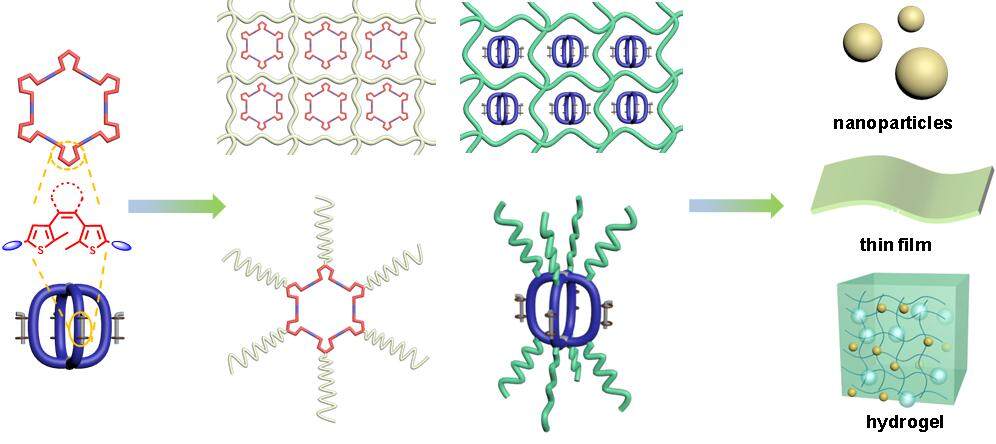Smart materials
Smart materials based on the diarylethene (DAE)-based supramolecular metallacycles and metallacages have become an evolving field of important interest[1]. In an excellent review by Qin et al.[2], the authors comment on the construction, photophysical and photochemical properties, and the applications of such smart materials [Scheme 1].
Scheme 1. Schematic representation of the noncovalent and covalent linkage of diarylethene-based metallacycles and metallacages with polymers and the subsequent formation of smart materials.
Integrating DAE subunits into a supramolecular coordination complex including metallacycle and metallacage can lead to smart materials with unique properties such as photo-responsive guest encapsulation/release, photo-controlled supramolecular transformation, and light-induced chirality switching[3,4]. Modulating coordination bonds could regulate the photochromic property of the DAE subunits such as photoconversion yield and enhanced fatigue-resistant property to some extent[5]. Smart materials with photochromic property could be applied to molecular machines, photodynamic therapy, and many other areas. If the synthesis and fundamental photophysical investigation of smart materials based on DAE-based metallacycles and metallacages made dazzling progress, their application needs more attention. For example, metallacages with photo-responsive guest encapsulation/release behavior may show interesting photo-controlled drug delivery ability, which could reduce the side effects of drugs and achieve precise theranostics[6]. The metallacycles and metallacages with photoswitchable fluorescence/magnetism could be applied in erasable molecular devices and in anti-counterfeiting[7]. The current DAE-based metallacycles and metallacages still have some drawbacks such as being fragile, not being solution processable, and being biologically incompatible, hampering further practical applications; new methods should be developed to address this issue. As polymers with unique properties and functions are easily processed and shaped[8], two general ways to further promote the applications of DAE-based metallacycles and metallacages in smart materials can be envisioned. The noncovalent linkage between the metallacycles or metallacages with the polymers will be the first choice. For example, doping the metallacycles or metallacages into the polymer matrix to form hydrogels or thin films or encapsulating the metallacycles or metallacages into amphiphilic polymers to form nanoparticles. The construction of polymer-functionalized metallacycles and metallacages (pre-modification and post-modification are both feasible) will become at second place[9]. Through integrating DAE-based metallacycles and metallacages and polymers into one entity, their further applications in smart materials could be realized. Such supramolecular synthetic chemistry will, without doubt, promote the development of modern material science.
DECLARATIONS
Authors’ contributionsThe author contributed solely to the article.
Availability of data and materialsNot applicable.
Financial support and sponsorshipThis project was financially supported by the National Natural Science Foundation of China (U1663225), Changjiang Scholar Program of Chinese Ministry of Education (IRT_15R52), the program of Introducing Talents of Discipline to Universities-Plan 111 (B20002) of Ministry of Science and Technology and the Ministry of Education of China and the supports from European Commission are highly acknowledged for the project “DepollutAir” in the frame of Interreg V France-Wallonie-Vlaanderen Program and the project of “Algae Factory” in the frame of the European Funds for Regional Development (FEDER) and from Walloon Government of Belgium for the project “TCharbonActif” in the frame of the Win2Wal program.
Conflicts of interestThe author declared that there are no conflicts of interest.
Ethical approval and consent to participateNot applicable.
Consent for publicationNot applicable.
Copyright© The Author(s) 2021.
REFERENCES
2. Qin Y, Wang YT, Yang HB, Zhu W. Recent advances on the construction of diarylethene-based supramolecular metallacycles and metallacages via coordination-driven selfassembly. Chem Synth 2021;1:2.
3. Han M, Michel R, He B, et al. Light-triggered guest uptake and release by a photochromic coordination cage. Angew Chem Int Ed Engl 2013;52:1319-23.
4. Gu Y, Alt EA, Wang H, Li X, Willard AP, Johnson JA. Photoswitching topology in polymer networks with metal-organic cages as crosslinks. Nature 2018;560:65-9.
5. Chen S, Chen LJ, Yang HB, Tian H, Zhu W. Light-triggered reversible supramolecular transformations of multi-bisthienylethene hexagons. J Am Chem Soc 2012;134:13596-9.
6. Chen GJ, Jaskula-Sztul R, Esquibel CR, et al. Neuroendocrine tumor-targeted upconversion nanoparticle-based micelles for simultaneous NIR-controlled combination chemotherapy and photodynamic therapy, and fluorescence imaging. Adv Funct Mater 2017;27:1604671.
7. Wu H, Chen Y, Liu Y. Reversibly photoswitchable supramolecular assembly and its application as a photoerasable fluorescent ink. Adv Mater 2017;29:1605271.
8. Kirillova A, Yeazel TR, Asheghali D, et al. Fabrication of biomedical scaffolds using biodegradable polymers. Chem Rev 2021; doi: 10.1021/acs.chemrev.0c01200.
Cite This Article
Export citation file: BibTeX | RIS
OAE Style
Su BL. Smart materials. Chem Synth 2021;1:4. http://dx.doi.org/10.20517/cs.2021.10
AMA Style
Su BL. Smart materials. Chemical Synthesis. 2021; 1(1): 4. http://dx.doi.org/10.20517/cs.2021.10
Chicago/Turabian Style
Su, Bao-Lian. 2021. "Smart materials" Chemical Synthesis. 1, no.1: 4. http://dx.doi.org/10.20517/cs.2021.10
ACS Style
Su, B.L. Smart materials. Chem. Synth. 2021, 1, 4. http://dx.doi.org/10.20517/cs.2021.10
About This Article
Copyright
Data & Comments
Data

 Cite This Article 18 clicks
Cite This Article 18 clicks














Comments
Comments must be written in English. Spam, offensive content, impersonation, and private information will not be permitted. If any comment is reported and identified as inappropriate content by OAE staff, the comment will be removed without notice. If you have any queries or need any help, please contact us at support@oaepublish.com.